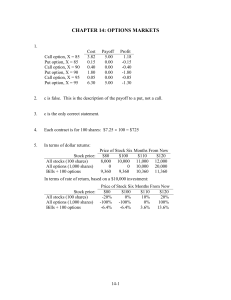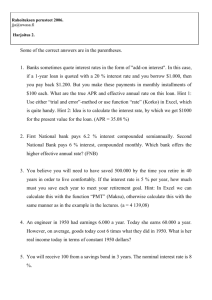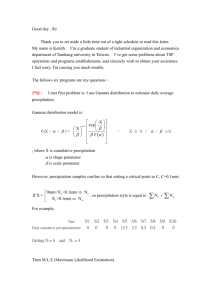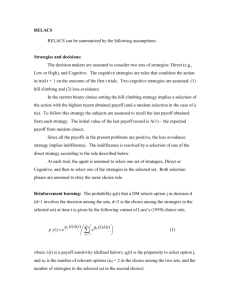Chapter 15
advertisement
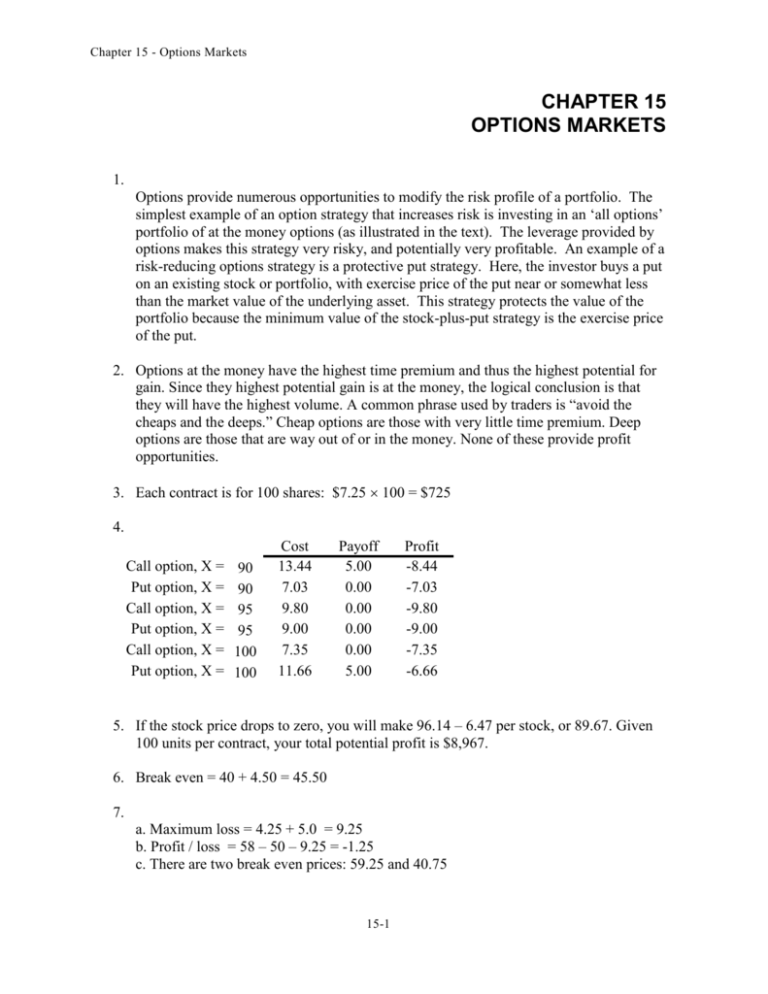
Chapter 15 - Options Markets CHAPTER 15 OPTIONS MARKETS 1. Options provide numerous opportunities to modify the risk profile of a portfolio. The simplest example of an option strategy that increases risk is investing in an ‘all options’ portfolio of at the money options (as illustrated in the text). The leverage provided by options makes this strategy very risky, and potentially very profitable. An example of a risk-reducing options strategy is a protective put strategy. Here, the investor buys a put on an existing stock or portfolio, with exercise price of the put near or somewhat less than the market value of the underlying asset. This strategy protects the value of the portfolio because the minimum value of the stock-plus-put strategy is the exercise price of the put. 2. Options at the money have the highest time premium and thus the highest potential for gain. Since they highest potential gain is at the money, the logical conclusion is that they will have the highest volume. A common phrase used by traders is “avoid the cheaps and the deeps.” Cheap options are those with very little time premium. Deep options are those that are way out of or in the money. None of these provide profit opportunities. 3. Each contract is for 100 shares: $7.25 100 = $725 4. Call option, X = Put option, X = Call option, X = Put option, X = Call option, X = Put option, X = 90 90 95 95 100 100 Cost 13.44 7.03 9.80 9.00 7.35 11.66 Payoff 5.00 0.00 0.00 0.00 0.00 5.00 Profit -8.44 -7.03 -9.80 -9.00 -7.35 -6.66 5. If the stock price drops to zero, you will make 96.14 – 6.47 per stock, or 89.67. Given 100 units per contract, your total potential profit is $8,967. 6. Break even = 40 + 4.50 = 45.50 7. a. Maximum loss = 4.25 + 5.0 = 9.25 b. Profit / loss = 58 – 50 – 9.25 = -1.25 c. There are two break even prices: 59.25 and 40.75 15-1 Chapter 15 - Options Markets 8. c is the only correct statement. 9. The collar involves purchasing a put for $3 and selling a call for $2. At all prices your net proceeds will be $39 per share. Given 5,00 shares, you will make 5,000 x 39 = 195,000 when the position is closed. 10. In terms of dollar returns: Price of Stock Six Months From Now Stock price: $80 $100 $110 $120 All stocks (100 shares) 8,000 10,000 11,000 12,000 All options (1,000 shares) 0 0 10,000 20,000 Bills + 100 options 9,360 9,360 10,360 11,360 In terms of rate of return, based on a $10,000 investment: Price of Stock Six Months From Now Stock price: $80 $100 $110 $120 All stocks (100 shares) -20% 0% 10% 20% All options (1,000 shares) -100% -100% 0% 100% Bills + 100 options -6.4% -6.4% 3.6% 13.6% 11. a. Purchase a straddle, i.e., both a put and a call on the stock. The total cost of the straddle would be: $10 + $7 = $17 b. Since the straddle costs $17, this is the amount by which the stock would have to move in either direction for the profit on either the call or the put to cover the investment cost (not including time value of money considerations). 15-2 Chapter 15 - Options Markets 12. a. Sell a straddle, i.e., sell a call and a put to realize premium income of: $4 + $7 = $11 b. If the stock ends up at $50, both of the options will be worthless and your profit will be $11. This is your maximum possible profit since, at any other stock price, you will have to pay off on either the call or the put. The stock price can move by $11 (your initial revenue from writing the two at-the-money options) in either direction before your profits become negative. c. Buy the call, sell (write) the put, lend the present value of $50. The payoff is as follows: Final Payoff Position Initial Outlay ST < X ST > X Long call C = 7 0 ST – 50 Short put -P = -4 -(50 – ST) 0 Lending 50/(1 + r)(1/4) 50 50 Total 7 – 4 + [50/(1 + r)(1/4)] ST ST The initial outlay equals: (the present value of $50) + $3 In either scenario, you end up with the same payoff as you would if you bought the stock itself. 13. a. By writing covered call options, Jones receives premium income of $30,000. If, in January, the price of the stock is less than or equal to $45, he will keep the stock plus the premium income. Since the stock will be called away from him if its price exceeds $45 per share, the most he can have is: $450,000 + $30,000 = $480,000 (We are ignoring interest earned on the premium income from writing the option over this short time period.) The payoff structure is: Stock price Portfolio value Less than $45 (10,000 times stock price) + $30,000 Greater than $45 $450,000 + $30,000 = $480,000 This strategy offers some premium income but leaves the investor with substantial downside risk. At the extreme, if the stock price falls to zero, Jones would be left with only $30,000. This strategy also puts a cap on the final value at $480,000, but this is more than sufficient to purchase the house. b. By buying put options with a $35 strike price, Jones will be paying $30,000 in premiums in order to insure a minimum level for the final value of his position. That minimum value is: ($35 10,000) – $30,000 = $320,000 This strategy allows for upside gain, but exposes Jones to the possibility of a moderate loss equal to the cost of the puts. The payoff structure is: Stock price Portfolio value Less than $35 $350,000 – $30,000 = $320,000 15-3 Chapter 15 - Options Markets Greater than $35 (10,000 times stock price) – $30,000 c. The net cost of the collar is zero. The value of the portfolio will be as follows: Stock price Portfolio value Less than $35 $350,000 Between $35 and $45 10,000 times stock price Greater than $45 $450,000 If the stock price is less than or equal to $35, then the collar preserves the $350,000 in principal. If the price exceeds $45, then Jones gains up to a cap of $450,000. In between $35 and $45, his proceeds equal 10,000 times the stock price. The best strategy in this case is (c) since it satisfies the two requirements of preserving the $350,000 in principal while offering a chance of getting $450,000. Strategy (a) should be ruled out because it leaves Jones exposed to the risk of substantial loss of principal. Our ranking is: (1) c (2) b (3) a 14. a. Butterfly Spread Position S < X1 0 Long call (X1) 0 Short 2 calls (X2) 0 Long call (X3) Total 0 X1 < S < X2 X2 < S < X3 S – X1 S – X1 0 –2(S – X2) 0 0 S – X1 2X2 – X1 – S b. Vertical combination Position S < X1 0 Long call (X2) Long put (X1) X1 – S Total X1 – S X1 < S < X2 0 0 0 15-4 X3 < S S – X1 –2(S – X2) S – X3 (X2–X1 ) – (X3–X2) = 0 S > X2 S – X2 0 S – X2 Chapter 15 - Options Markets 15. Bearish spread Position Long call (X2) Short call (X1) Total S < X1 0 0 0 X1 < S < X2 0 –(S – X1) X1 – S S > X2 S – X2 –(S – X1) X1 – X2 In the bullish spread, the payoff either increases or is unaffected by stock price increases. In the bearish spread, the payoff either increases or is unaffected by stock price decreases. 16. a. . Protective Put Stock Put Total ST < 1040 ST 1040 – ST 1040 ST > 1040 ST 0 ST Bills and Call Bills ST < 1120 1120 ST > 1120 1120 15-5 Chapter 15 - Options Markets Call Total ST – 1120 ST 0 1120 Payoff Bills plus calls (Dashed line) 1120 1040 Protective put strategy (Solid line) ST 1040 1120 b. The bills plus call strategy has a greater payoff for some values of ST and never a lower payoff. Since its payoffs are always at least as attractive and sometimes greater, it must be more costly to purchase. c. The initial cost of the stock plus put position is $1,208 and the cost of the bills plus call position is $1,240. Position ST = 0 ST = 1040 ST = 1120 ST = 1200 ST = 1280 Stock 0 1040 1120 1200 1280 + Put 1040 0 0 0 0 Payoff 1040 1040 1120 1200 1280 Profit -168 -168 -88 -8 +72 Position ST = 0 ST = 1040 ST = 1120 ST = 1200 ST = 1280 Bill 1120 1120 1120 1120 1120 + Call 0 0 0 80 160 Payoff 1120 1120 1120 1200 1280 Profit -120 -120 -120 -40 +40 15-6 Chapter 15 - Options Markets Profit Protective put Bills plus calls 1040 1120 ST -120 -168 d. The stock and put strategy is riskier. It does worse when the market is down, and better when the market is up. Therefore, its beta is higher. 17. The Excel spreadsheet for both parts (a) and (b) is shown on the next page, and the profit diagrams are on the following page. a. & b. Stock Prices Beginning Market Price Ending Market Price 116.5 130 Ending Buying Options: Call Options Strike 110 120 130 140 Price 22.80 16.80 13.60 10.30 Payoff 20.00 10.00 0.00 0.00 Profit -2.80 -6.80 -13.60 -10.30 Return % -12.28% -40.48% -100.00% -100.00% Put Options Strike 110 120 130 140 Price 12.60 17.20 23.60 30.50 Payoff 0.00 0.00 0.00 10.00 Profit -12.60 -17.20 -23.60 -20.50 Return % -100.00% -100.00% -100.00% -67.21% Straddle 110 120 130 140 Price 35.40 34.00 37.20 40.80 Payoff 20.00 10.00 0.00 10.00 Profit -15.40 -24.00 -37.20 -30.80 Return % -43.50% -70.59% -100.00% -75.49% 15-7 Stock Price 50 60 70 80 90 100 110 120 130 140 150 160 170 180 190 200 210 X 130 Straddle Profit -37.20 42.80 32.80 22.80 12.80 2.80 -7.20 -17.20 -27.20 -37.20 -27.20 -17.20 -7.20 2.80 12.80 22.80 32.80 42.80 Chapter 15 - Options Markets Selling Options: Call Options Strike 110 120 130 140 Price 22.80 16.80 13.60 10.30 Payoff -20 -10 0 0 Profit 2.80 6.80 13.60 10.30 Return % 12.28% 40.48% 100.00% 100.00% 110 120 130 140 Price 12.60 17.20 23.60 30.50 Payoff 0 0 0 10 Profit 12.60 17.20 23.60 40.50 Return % 100.00% 100.00% 100.00% 132.79% Price Payoff Profit 16.80 13.60 10.00 0 10.00 Put Options Strike Money Spread Bullish Spread Purchase 120 Call Sell 130 Call Combined Profit -6.80 13.60 6.80 Ending Stock Price 50 60 70 80 90 100 110 120 130 140 150 160 170 180 190 200 210 Bullish Spread Spreads and Straddles 50.00 40.00 30.00 20.00 10.00 130 Straddle 0.00 0 50 100 150 -10.00 -20.00 -30.00 -40.00 -50.00 Stock Price 15-8 200 250 Bullish Spread 6.80 -3.2 -3.2 -3.2 -3.2 -3.2 -3.2 -3.2 -3.2 6.8 6.8 6.8 6.8 6.8 6.8 6.8 6.8 6.8 Chapter 15 - Options Markets 18. The bondholders have, in effect, made a loan which requires repayment of B dollars, where B is the face value of bonds. If, however, the value of the firm (V) is less than B, then the loan is satisfied by the bondholders taking over the firm. In this way, the bondholders are forced to “pay” B (in the sense that the loan is cancelled) in return for an asset worth only V. It is as though the bondholders wrote a put on an asset worth V, with exercise price B. Alternatively, one can view the bondholders as giving to the equity holders the right to reclaim the firm by paying off the B dollar debt. The bondholders have issued a call to the equity holders. 19. The executive receives a bonus if the stock price exceeds a certain value, and receives nothing otherwise. This is the same as the payoff to a call option. 20. a. Position Short call Short put Total S < 95 0 – (95 –S) S – 95 95 < S < 100 0 0 0 S > 100 – (S – 100) 0 100 – S Payoff 95 100 Write put ST Write call b. Proceeds from writing options (from Figure 15.1): Call = $7.35 Put = $9.00 Total = $16.35 If IBM is selling at $97, both options expire out of the money, and profit equals $16.35. If IBM is selling at $105, the call written results in a cash outflow of $5 at maturity, and an overall profit of: $16.35 – $5.00 = $11.35 15-9 Chapter 15 - Options Markets c. You break even when either the short position in the put or the short position in the call results in a cash outflow of $16.35. For the put, this requires that: $16.35 = $95 – S S = $78.65 For the call this requires that: $16.35 = S – $100 S = $116.35 d. The investor is betting that the IBM stock price will have low volatility. This position is similar to a straddle. 21. The put with the higher exercise price must cost more. Therefore, the net outlay to establish the portfolio is positive. 22. Buy the X = 62 put (which should cost more than it does) and write the X = 60 put. Since the options have the same price, the net outlay is zero. Your proceeds at maturity may be positive, but cannot be negative. Position ST < 60 60 < ST < 62 ST > 62 Long put (X = 62) 0 62 – ST 62 – ST Short put (X = 60) 0 0 – (60 – ST) Total 2 0 62 – ST 15-10 Chapter 15 - Options Markets 23. The following payoff table shows that the portfolio is riskless with time-T value equal to $10. Therefore, the risk-free rate is: ($10/$9.50) – 1 = 0.0526 = 5.26% Position ST < 10 ST > 10 Buy stock ST ST Short call 0 – (ST – 10) Long put 0 10 – ST Total 10 10 24. a. Joe’s strategy Position Stock index Long put (X = 1200) Total Profit = payoff – 1260 Sally’s Strategy Initial Outlay 1200 60 1260 Final Payoff ST < 1200 ST > 1200 ST ST 1200 – ST 0 1200 ST -60 ST – 1260 Position Stock index Long put (X = 1170) Total Profit = payoff – 1245 Initial Outlay 1200 45 1260 Final Payoff ST < 1170 ST > 1170 ST ST 1170 – ST 0 1170 ST -75 ST – 1245 Profit Sally 1170 1200 Joe ST -60 -75 b. Sally does better when the stock price is high, but worse when the stock price is low. (The break-even point occurs at S = $1185, when both positions provide losses of $60.) c. Sally’s strategy has greater systematic risk. Profits are more sensitive to the value of the stock index. 25. This strategy is a bear spread. The initial proceeds are: $9 – $3 = $6 15-11 Chapter 15 - Options Markets The payoff is either negative or zero: Position ST < 50 50 < ST < 60 Long call (X = 60) 0 0 Short call (X = 50) 0 – (ST – 50) Total 0 – (ST – 50) ST > 60 ST – 60 – (ST – 50) –10 Breakeven occurs when the payoff offsets the initial proceeds of $6, which occurs at a stock price of ST = $56. 26. Buy a share of stock, write a call with X = 50, write a call with X = 60, and buy a call with X = 110. Position ST < 50 50 < ST < 60 60 < ST < 110 ST > 110 Buy stock ST ST ST ST Short call (X = 50) 0 – (ST – 50) – (ST – 50) – (ST – 50) Short call (X = 60) 0 0 – (ST – 60) – (ST – 60) Long call (X = 110) 0 0 0 ST – 110 Total 50 0 ST 110 – ST The investor is making a volatility bet. Profits will be highest when volatility is low so that the stock price ends up in the interval between $50 and 27. The farmer has the option to sell the crop to the government, for a guaranteed minimum price, if the market price is too low. If the support price is denoted PS and the market price PM then we can say that the farmer has a put option to sell the crop (the asset) at an exercise price of PS even if the market price of the underlying asset (PM) is less than PS. CFA 1 15-12 Chapter 15 - Options Markets c is false. This is the description of the payoff to a put, not a call. CFA 2 a. Donie should choose the long strangle strategy. A long strangle option strategy consists of buying a put and a call with the same expiration date and the same underlying asset, but different exercise prices. In a strangle strategy, the call has an exercise price above the stock price and the put has an exercise price below the stock price. An investor who buys (goes long) a strangle expects that the price of the underlying asset (TRT Materials in this case) will either move substantially below the exercise price on the put or above the exercise price on the call. With respect to TRT, the long strangle investor buys both the put option and the call option for a total cost of $9.00, and will experience a profit if the stock price moves more than $9.00 above the call exercise price or more than $9.00 below the put exercise price. This strategy would enable Donie's client to profit from a large move in the stock price, either up or down, in reaction to the expected court decision. b. i. The maximum possible loss per share is $9.00, which is the total cost of the two options ($5.00 + $4.00). ii. The maximum possible gain is unlimited if the stock price moves outside the breakeven range of prices. iii. The breakeven prices are $46.00 and $69.00. The put will just cover costs if the stock price finishes $9.00 below the put exercise price ($55 − $9 = $46), and the call will just cover costs if the stock price finishes $9.00 above the call exercise price ($60 + $9 = $69). CFA 3 a. If an investor buys a call option and writes a put option on a T-bond, then, at maturity, the total payoff to the position is (ST – X), where ST is the price of the T-bond at the maturity date (time T) and X is the exercise price of the options. This is equivalent to the profit on a forward or futures position with futures price X. If you choose an exercise price (X) equal to the current T-bond futures price, then the profit on the portfolio replicates that of market-traded futures. b. Such a position would increase the portfolio duration, just as adding a T-bond futures contract increases duration. As interest rates fall, the portfolio increases in value, so that duration is longer than it was before the synthetic futures position was established. 15-13 Chapter 15 - Options Markets c. Futures can be bought and sold very cheaply and quickly. They give the manager flexibility to pursue strategies or particular bonds that seem attractively priced without worrying about the impact of these actions on portfolio duration. The futures can be used to make adjustments to duration necessitated by other portfolio actions. CFA 4 a. Conversion value of a convertible bond is the value of the security if it is converted immediately. That is: Conversion value = market price of common stock × conversion ratio = $40 × 22 = $880 b. Market conversion price is the price that an investor effectively pays for the common stock if the convertible bond is purchased: Market conversion price = market price of the convertible bond/conversion ratio = $1,050/22 = $47.73 CFA 5 a. i. The current market conversion price is computed as follows: Market conversion price = market price of the convertible bond/conversion ratio = $980/25 = $39.20 ii. The expected one-year return for the Ytel convertible bond is: Expected return = [(end of year price + coupon)/current price] – 1 = [($1,125 + $40)/$980] – 1 = 0.1888 = 18.88% iii. The expected one-year return for the Ytel common equity is: Expected return = [(end of year price + dividend)/current price] – 1 = ($45/$35) – 1 = 0.2857 = 28.57% b. The two components of a convertible bond’s value are: the straight bond value, which is the convertible bond’s value as a bond, and; the option value, which is the value associated with the potential conversion into equity. i. In response to the increase in Ytel’s common equity price, the straight bond value should stay the same and the option value should increase. The increase in equity price does not affect the straight bond value component of the Ytel convertible. The increase in equity price increases the option value component significantly, because the call option becomes deep “in the money” when the $51 per share equity price is compared to the convertible’s conversion price of: $1,000/25 = $40 per share. ii. In response to the increase in interest rates, the straight bond value should decrease and the option value should increase. 15-14 Chapter 15 - Options Markets The increase in interest rates decreases the straight bond value component (bond values decline as interest rates increase) of the convertible bond and increases the value of the equity call option component (call option values increase as interest rates increase). This increase may be small or even unnoticeable when compared to the change in the option value resulting from the increase in the equity price. 15-15
